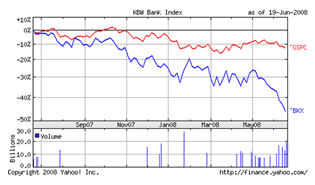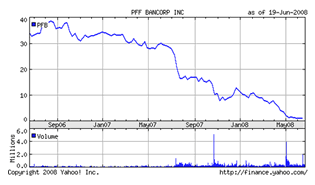
The second quarter of 2008 will always be remembered as a time when the banking industry’s tenuous optimism about a light recession and mild credit issues turned into the worst environment in 30 years. Now, the potential exists that we’ll slip further into the most dire banking and economic times since FDR was wheeling around Dubbya’s current office.
The stress level in the banking industry has just moved to DEFCON 1. We are in for both a horrible remainder of 2008 and an even worse 2009.
In this mid-year Gonzo update, I would like to:
a) share some information about how bad things have gotten in the past 30 days;
b) moralize for a moment about how asleep our industry was (again) as this crisis approached; and
c) identify key priorities for bankers as we head straight into these dark clouds.
Headlines in the last few weeks signal a rapid downhill slide:



The worst part about this economic malaise is the risk that not all of this pain will go away by 2010. Investment speculator George Soros has characterized the current environment as a “run on the U.S.” as our currency has dropped dramatically and financial market credibility has moved more overseas.
Right now the media is full of prognostications about what happens next in this dreary storm. Former Treasury Secretary Robert Rubin wins my award for the wimpiest prediction yet: “We are in a very uncertain and complex environment. There are a range of possibilities and we can wind up anywhere in that spectrum.” (Newsweek – June 16, 2008). Thanks for taking a stand there, Bob!
So, GonzoBankers, here are some quick thoughts from a group of half-cocked bank consultants that actually saw this mess coming and rang the warning bell a long time ago:
In August 2001, Gonzo wrote:
“For the average retail customer, it’s not time to accept lower grade paper, to lengthen repayment terms so these poor folks can qualify for more debt, or to acquire any ‘entrepreneurial’ finance companies that know how to close deals that are bad for consumers. It’s time for the banker to say, ‘Slow down Fred… this stuff’s gonna kill ya!’”
In January 2005, Gonzo wrote:
“Consumers and businesses have entrusted our industry to keep an eye on their financial health. Banks can have a profound influence on the current and future generations’ attitudes towards debt. So far, our industry has only condoned and encouraged the growth of the new, highly leveraged consumer. Is it time to do the right thing and change our tune a bit?” (Note the economic cycle prediction we made back then and compare it to now!)
In December 2006, Gonzo wrote:
“By the third quarter of next year [2007], the banking industry will have acknowledged that the screeching slowdown in the housing boom and real estate cycle will create greater credit losses than any executive team had projected. Increasing provisions and weak earnings late in the year will lead to many banks throwing out their 2007 earnings with either large write-offs or a merger/sale transaction.”
The saddest part about the historical downturn we are experiencing is that it could have been avoided with common sense. Of course, historian David McCullough put it best when he remarked, “One of the lessons of history surely is that common sense isn’t that common.”
Sure, most of the blame could fall on Wall Street, sub-prime mortgage companies and big banks. But we should all be asking, “Where was the outrage and warnings from the rooftops?” When Fannie and Freddie appeared to be smoking something illegal by nationalizing “liar loans,” why did our industry merely plow more product their way? Didn’t we think such a blatant economic distortion might take all of us down at some point?
If there is anything to learn from this crisis, it’s to remember that the job of the banker is to steer money to the right places. We are the optimization funnel for our economy and our society. When we don’t do our jobs, everyone gets hurt. In the past 10 years, bankers let go of their role of being prudent skeptics and instead jumped on the “money for nothin’ and your chicks for free” bandwagon.
What’s Next?
There are three economic wild cards whose outcome will foretell if we get through this soon or if it’s time to hoard bags of grain, propane and firearms.
Wild Card #1: Foreclosure behavior – Nearly 8.5 million homeowners had negative or no equity in their homes at the end of March, representing more than 16 percent of all homeowners with mortgages, said Mark Zandi, chief economist at Moody’s Economy.com. Zandi estimates that figure will increase to 12.2 million, or almost one out of every four homeowners, by the end of June. It’s just too hard to predict how “fashionable” it will become for consumers to hand over the house keys to lenders, but it could end up much higher in ’09 than it is today.
Wild Card #2: Commercial real estate – So far, this has been a consumer residential and developer/homebuilder led crisis. The CRE crisis experienced by S&Ls has not reared its head just yet, but it certainly could. The National Association of Realtors recently reported that commercial real estate investment was down 69 percent from a year ago. Vacancies have not yet reached critical levels, but even non-construction CRE delinquencies were up in banks nearly 30% for the first quarter 2008.
Wild Card #3: Stagflation – As the Fed tries to walk a fine line between avoiding recession and staving off inflation, we may end up with the worst outcome of all: Jimmy Carter era stagflation. The Wall Street Journal reported on June 9, “The current Washington policy mix of easy money and Keynesian fiscal ‘stimulus’ is taking us down the road to stagflation.” Since the Fed began cutting short rates last summer, the price of crude has gone from $80 a barrel to nearly $140. This could make for a wild ride in asset liability management committee.
Eight Keys to Survive Banking’s Dark Ages
It’s damn serious out there right now, GonzoBankers.
We’re all buckling down for survival, hoping to successfully meet for beers and celebration on the other side. Here are eight key rules that the survivors will live by to make it to the party:
#1: Survivors will hoard capital – Because the bottom of this cycle cannot be felt yet, capital preservation is the highest priority. We will see modest growth if not shrinking in many balance sheets, an unwinding of marginal assets and more costly funding and continuous attempts to raise new capital.
#2: Survivors will make their credit risk more transparent – Credibility will only be established with spooked investors when bank managers can talk in detail and with confidence about the inherent risks, behaviors and expected outcomes of their portfolios. It’s time to slice and dice loan information with the database, conduct those exhaustive portfolio reviews and improve the detail and transparency of loan reports.
#3: Survivors will formally monitor external risks – Want to talk management dashboards? Every bank right now needs a monthly report tracking foreclosures, median home values, CRE vacancies and inventory that’s shared with the board as well.
#4: Survivors will dump their growth cultures and morph into profit cultures – The entire vocabulary in banks the past 10 years has been about growth. Pricing suffered, credit suffered and efficiency suffered. Bankers should expect heightened profitability reporting, tougher business case requirements for investments and profit-based incentive programs going forward.
#5: Survivors will make tough choices on efficiency – In the next 18 months, we’ll see not only layoffs, but accelerated branch sales/closings, line of business divestitures and hard-nosed focus on process improvement and automation.
#6: Survivors will work overtime for better asset spreads – One silver lining to this credit crisis is that risk premiums are finally coming back into lending after a long hiatus. While franchise value is certainly driven primarily from the growth in deposits, banks need to be opportunistic about near-term prospects to increase earnings with stronger asset yields. A steepening yield curve should help bankers in this area as well.
#7: Survivors will regain their honor and quit misleading the American consumer – The jig is up. The government, media and family households are onto the fact that financial companies made too much with hidden fees, fine print and unjustified yields. (Business Week just reported that internal training materials at World Savings encouraged loan originators to use the term “deferred interest” instead of negative amortization with prospective borrowers– oh brother!) Let’s take a page from Vanguard, ING Direct and USAA and start earning money the old fashioned way – value.
#8: Survivors will dig, innovate and make focused opportunistic moves – I recently saw Wells Fargo Chairman Dick Kovacevich talking like a kid in a candy store about the strategic opportunities in the current banking environment. His recent big buys of his company’s stock put credence behind his optimistic talk. Even though things are tough, every bank planning to survive needs to keep its core growth strategies alive. We all need to be looking for acquisition values, dreaming up new products and services, and finding cost effective ways to expand. Remember how much the S&L crisis sucked? But let’s also remember how Bank of America bulked during that time by buying thrift deposits on the cheap. Back in the S&L crisis, Kurt Cobain was blasting out the first chords of grunge in the same town where a sleepy thrift named Washington Mutual started its moves to become a major retail banking player. Remember back in the early ’90s when Commerce Bank of New Jersey was $1 billion with 650 employees? After 15 years of innovation, culture-building, risk-taking and organic expansion, the bank was $50 billion when it sold to TD. While we work urgently to survive, remember that the leaders of the next “renaissance” in banking are already making plans.
Will You Be A Strong Survivor?
In the past 90 days, our dark times got even darker. We’re really at the end of the beginning but not close to the beginning of the end. Someday gray-haired bankers will reminisce over Scotch and cigars how they remember getting through the sub-prime and housing crisis of the early 21st Century. Here’s a toast to all of you out there who are buckling down with a vengeance to be some of those surviving bankers.
–spw